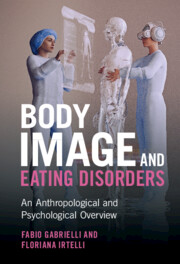Book contents
- Body Image and Eating Disorders
- Body Image and Eating Disorders
- Copyright page
- Contents
- Acknowledgments
- Part I Contemporary Perspectives in Anthropology, Philosophy, and Psychology on the Human Body: An Introductory Overview
- Part II Brain without Body, Body without Brain, and Contemporary Body Image Disorders
- Part III The Hypermodern Contradictory Relationship with Food
- 6 Contemporary Social Trends Regarding Food: Paradoxes and Food Tribes
- 7 A New Disorder: Orthorexia
- 8 Contemporary Perspectives on Anorexia
- 9 Nervous Bulimia and Binge Eating Disorder
- 10 Contemporary Perspectives on Obesity
- Part IV Which Possible Horizons? Some Final Considerations
- References
- Index
8 - Contemporary Perspectives on Anorexia
from Part III - The Hypermodern Contradictory Relationship with Food
Published online by Cambridge University Press: 26 May 2022
- Body Image and Eating Disorders
- Body Image and Eating Disorders
- Copyright page
- Contents
- Acknowledgments
- Part I Contemporary Perspectives in Anthropology, Philosophy, and Psychology on the Human Body: An Introductory Overview
- Part II Brain without Body, Body without Brain, and Contemporary Body Image Disorders
- Part III The Hypermodern Contradictory Relationship with Food
- 6 Contemporary Social Trends Regarding Food: Paradoxes and Food Tribes
- 7 A New Disorder: Orthorexia
- 8 Contemporary Perspectives on Anorexia
- 9 Nervous Bulimia and Binge Eating Disorder
- 10 Contemporary Perspectives on Obesity
- Part IV Which Possible Horizons? Some Final Considerations
- References
- Index
Summary
What is nervous anorexia? How widespread is it today? What are the family and cultural phenomena to which it relates? How does it relate to body image? In this chapter diverse aspects of this disorder and of the relationship context in which it develops are analyzed and some social dynamics related to this disease are presented. For example, the way in which some popular social media platforms have begun to admit the risks inherent in exposure to certain types of photos is discussed, such as Instagram’s ban on the hashtag "proanorexia,” which was deemed to actively promote self-harm. Considerable attention is paid to the topic of nervous anorexia given the significant increase in cases of this eating disorder in recent decades that coincides with the concurrent excessive focus on food in some contemporary cultures and along with the positive value attached to being thin. The number of scientific studies focusing on eating disorders has also dramatically increased in response to such phenomena and particularly in relation to Westernized societies where the emphasis on thinness is particularly pronounced. Indeed, it is increasingly the case that many adolescent girls experience distress on account of their physical appearance and, fearing weight gain, deprive themselves of food leading to dangerously excessive weight loss. The clinical features of anorexia as well as theories, clinical cases, and scientific studies on the topic are presented.
Keywords
- Type
- Chapter
- Information
- Body Image and Eating DisordersAn Anthropological and Psychological Overview, pp. 100 - 106Publisher: Cambridge University PressPrint publication year: 2022

